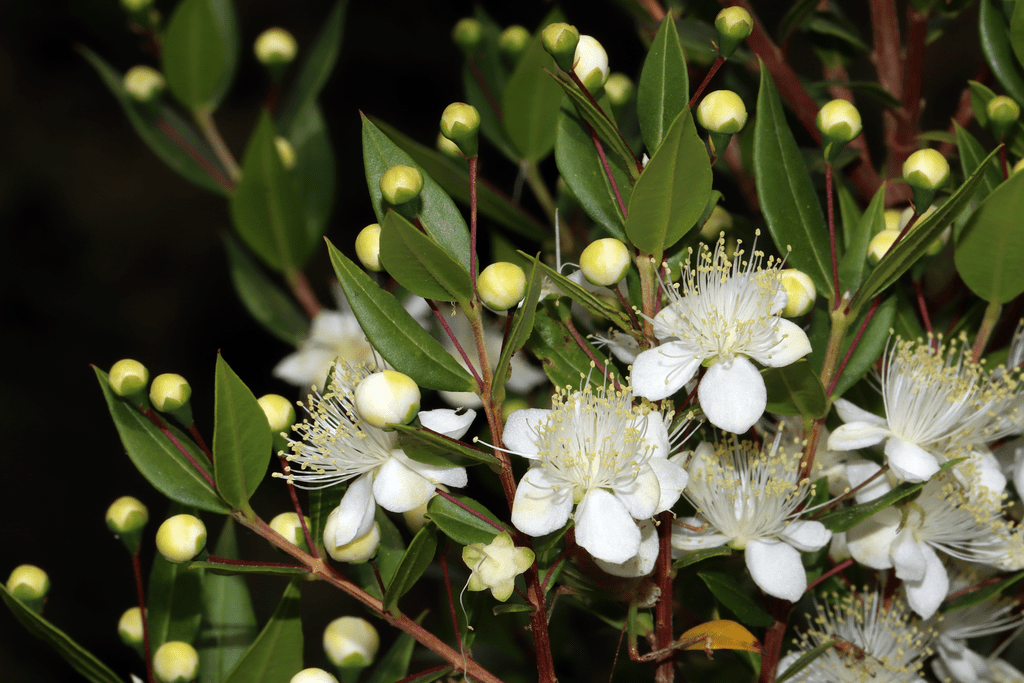
Description
A species of flowering plant belonging to the Myrtle family, Myrtus communis is also known as true myrtle or common myrtle. The plant has short, leathery, lanceolate, dark green leaves. Late summer brings bowl-shaped, fuzzy, white blooms. The tasty fleshy fruit of myrtle, which resembles the size and color of purplish-black blueberries, ripens in October, but only after a long, warm summer. A fruit can yield up to thirty seeds. With age, the cinnamon-colored bark peels and gets furrowed while the trunk gradually thickens. Despite having a bushy habit by nature, common myrtle can be trained to grow as a tiny bonsai, an upright little tall tree, or a low-mounding spreading shrub.
Habitat
This evergreen shrub is native to the Indian Subcontinent, Macaronesia, North Africa, Western Asia, and Southern Europe. It is commonly cultivated in these regions.
Uses
Chemicals found in myrtle may be able to lessen edema and combat germs and fungus. Myrtle is used to treat a variety of ailments, including warts, persistent heartburn, acne, canker sores, and very heavy menstrual bleeding.

Varieties
Tarentina is another name for Common Myrtle, or Tarentum Myrtle. This compact, bushy myrtle grows to a height of three to six feet and a width of three to six feet, so plant it in smaller gardens.
“Tarentina Variegata” features pale yellow leaves with green streaks and a growth habit akin to the original Tarentina.
‘Nana’ is roughly five feet tall with particularly small leaves.
The ‘Compacta’ type grows to a maximum height of 6 to 8 feet.
With its chimeral yellow to white leaves variegation, “Compacta Variegata” grows similarly to the original Compacta.
‘Buxifolia’ is a very small-leafed, low dwarf cultivar.
Plant Care
Planting Myrtus communis in raised beds, containers, hedges, borders, or as a stand-alone accent are all possible options. Myrtle is a low-maintenance, drought-tolerant, and deer-resistant plant that looks good in many kinds of gardens, from coastal to city, where it will gently fill in any protected, sunny spot.
- Light
Provide full to partial sun for the plant and place it in a west or south facing spot that is protected from the chilly, drying wind. It needs a lot of light and air if grown inside as a bonsai. Place outside in the sweltering summer shade. Bring inside to a cold environment that is approximately 50 degrees Fahrenheit in the autumn. Put under grow lights or on a windowsill facing south.
- Soil
Establish Myrtus communis in moist but well-drained soil. It will adapt to clay or sand, though, for best results, plant under glass in loam-based compost in filtered light with good ventilation.
Beware of iron chlorosis in highly alkaline soil that has a pH higher than 8.3. If this occurs, lower the soil pH with a treatment of elemental sulfur or nitrogen fertilizer.
- Water
Plant Myrtus communis on soil that is damp but drains properly. Although it can grow in sand or clay, planting under glass in compost made of loam under filtered light with adequate ventilation will yield the greatest results.
When the pH of very alkaline soil exceeds 8.3, be cautious of iron chlorosis.
High levels of lime, as in tap water, are not good for myrtle. The plant might benefit from rainwater collection for irrigation.
- Temperature and Humidity
The myrtle is frost tender and hardy to 10 degrees Fahrenheit, making it hardy in USDA Zones 8 through 11. It can’t stand very humid conditions.
- Fertilizer
Fertilize outdoors once a year in the early spring. During the growing season, use a liquid fertilizer once a week indoors. In the winter, keep an eye on the plant; if it’s growing at all, you might need to fertilize it every two weeks.
Table





